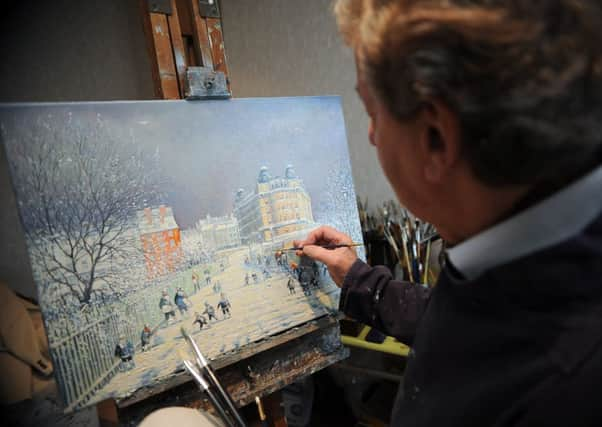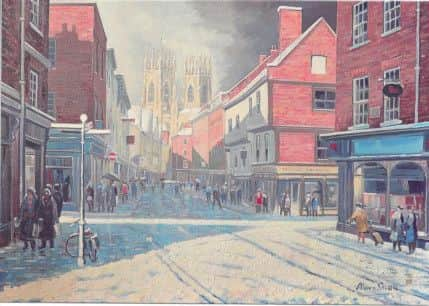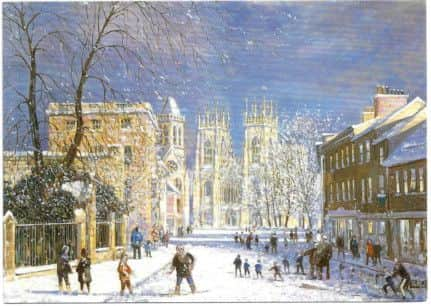Snow brush at the ready


Pablo Picasso’s observation that the meaning of life is to find your gift, and the purpose of life is to give it away is very dear to the heart of Scarborough-based artist Alan Stuttle. He can command good prices for his original art, but making it available to the general public through charitable acts figures high on his personal agenda. One such act is designing Christmas cards for local and national charities.
He designed his first Christmas card more than 40 years ago and since then he estimates that his designs have accounted for over five million cards worldwide. Most of his work designing Christmas cards is done without charge. One of his most famous efforts for the NSPCC featured a young girl eating snow and that sold many thousands for the charity. He met up with the Duke of Westminster – the NSPCC’s main patron – to be congratulated for his efforts.
Advertisement
Hide AdAdvertisement
Hide AdThere is a desperately sad footnote to that “girl eating snow” portrait because the model for the card was his then four-year-old daughter Caroline. It brings back great sadness to him these days, for Caroline was killed 12 years ago while backpacking in Australia at the age of just 19.


“I called that card First Taste of Snow because it was like the first taste of life when I watched her eating snow. Something very special. Caroline may be gone from our world, but through this image she lives forever in my mind,” Alan reflects.
The key symbols for his best-selling traditional cards are churches, snow, robins and children. The Lowry influence is there to see for many of his best-selling cards are wintry streetscapes.
“As soon as it starts to snow I’m outside painting. Fallen snow is in many ways an easy thing to paint because it puts a cover on everything. On the other hand, it reshapes the landscape in a subtle and fascinating manner.”
Advertisement
Hide AdAdvertisement
Hide AdThe style of some of Alan’s cards is, in many ways, a throwback to Victorian times, but colour is the most vital aspect of his card design.


“You have to use blues and whites and pastels to convey the coldness of the season” he says. “But it’s important that the card carries warm colours too – reds, browns, yellows, oranges – so that people sense the cosiness of being inside and safe from the elements. It’s a combination of the two.”
Being principally a landscape artist, Alan does not go in for deeply religious cards with nativity scenes or icons of Christ.
Although he hails from Cheshire, he has lived in Yorkshire for 40 years, with galleries in York and Scarborough, and regards himself as an adopted son of the county. “I’ve designed many cards based on York street scenes. The Minster is such a magnificent building that it makes a powerful picture. I’ve also featured the Mansion House, and the Shambles is very atmospheric when there’s a snowfall.
Advertisement
Hide AdAdvertisement
Hide Ad“In Scarborough, the harbour in snow offers a Christmassy setting and the Grand Hotel is very eye-catching.”
Although he donates most of his Christmas card designs free to deserving causes, a few years ago he was commissioned to produce a set of four cards for Harrods which proved quite a lucrative venture. Alan acknowledges that digital photography has made significant inroads into the Christmas card sector but he is not downhearted by the challenge.
“A photograph may be a more accurate representation of a scene but it lacks the warmth and personality that an artist can bring to it. A good artist can use his emotions to interpret the scene he is painting and people can identify with that.”
The invention of the Christmas card is attributed to Sir Henry Cole who, in 1843, commissioned the artist John Calcott Horsley to create a card showing three generations of one family toasting whoever would be the card’s receiver.
Advertisement
Hide AdAdvertisement
Hide AdThat all those early popular Victorian cards were created by artists probably helps reinforce the idea that a real Christmas card is a painted representation. Indeed, many such cards have become collectors’ items and have a price on them. The Laura Seddon Greeting Card Collection, where many of the best-selling Victorian cards can be viewed, is housed at Manchester Metropolitan University.
It would be incorrect to think that the Victorians favoured religious imagery on their Christmas cards; their preferences were for flowers, fairies and fanciful designs. Humorous and sentimental images of children and animals became popular with the developing Victorian concept of childhood.
The challenge provided by photography has forced Alan to be more inventive too. His impish sense of humour has given him some new concepts.
If he was to design a card for one child to send to another does he have any ideas for an original design?
Advertisement
Hide AdAdvertisement
Hide Ad“What about a scene showing the home of Father Christmas and Mother Christmas? They are each sitting in their chairs surrounded by the stuff of Christmas. For Father Christmas it might be stacks and stacks of wrapped Christmas presents. For Mother Christmas it would be food she is preparing for the big day.”
Alan’s gallery is on North Marine Road in Scarborough and most cricket fans walk past it on their way to the cricket ground. Passing aficionados are lured into the gallery by some of his caricatures – he loves capturing tramps, buskers and the down and outs of society. This year, to celebrate Yorkshire winning the County Championship, he has developed an idea for a card that shows a match being played at the ground on Christmas Day – in a snowstorm. He expects plenty of takers!
“Oh yes” he will tell the curious browser “didn’t you know there is traditionally a game at North Marine Road on Christmas Day?
“Of course, it’s a pack of lies, but only intended as a bit of Christmas fun.”
Advertisement
Hide AdAdvertisement
Hide AdThere is the false notion that the Christmas card is dying a death, but how can it be when almost 700 million were sent last year?
Indeed, people thought the practice had been killed off by the First World War. The advent of the postcard seriously affected the market too, only for cards in envelopes to resume their popularity in the 1920s.
Most people ease their consciences by buying charity Christmas cards in the false belief that they are hugely benefitting the good cause they support.
The truth is that many commercial charity cards give only a tiny percentage of their take to the charity. The Charity Advisory Trust gives the annual Scrooge award to the Christmas Card company that gives the lowest percentage of its revenue to charity.
Last year’s winner was Asda. Debenhams won in 2012. Unsurprisingly, it is an award no- one wants.